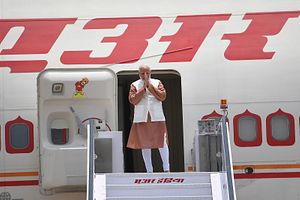Ahead of Indian Prime Minister Narendra Modi’s visit to Indonesia this week, Jakarta indicated that it is starting to take India’s growing profile in the wider Indo-Pacific seriously. In a recent speech in New Delhi, Luhut Pandjaitan, Indonesia’s coordinating minister for maritime affairs, indicated that Indonesia will be providing India access to the strategic island of Sabang at the northern tip of Sumatra and close to the Malacca Strait, where India is likely to invest in the port and an economic zone. Rapidly evolving regional strategic realities are now forcing India and Indonesia to coordinate their policies ever more closely and after years of neglect; Jakarta is recognizing the role that New Delhi can play in structuring a favorable balance of power in the region.
Indonesian President Joko Widodo had visited India in December 2016 with a promise to elevate India-Indonesia ties. During that visit, the two nations had taken aim at China’s aggressive stance on the South China Sea when they “stressed the importance of resolving disputes by peaceful means, in accordance with universally recognized principles of international law, including UNCLOS.” This is significant as both India and Indonesia do not have a direct stake in this dispute. But both are concerned about China’s territorial expansionism and its reluctance to abide by global norms. Modi and Widodo also want their nations to emerge as major maritime powers to ensure a stable maritime order in the region, one that is under stress because of China’s rapid rise and America’s growing reluctance to be the sole guarantor of regional security. Where India is worried about the security of the sea lanes of communication in the larger Indo-Pacific area, Indonesia has been concerned about Chinese maritime intrusions near the Natuna islands, which it claims as part of its exclusive economic zone, as well as Chinese attempts in the past to include the island chain in its territorial maps.
Against the backdrop of the rapidly changing security agenda facing the two nations, they have also now agreed to focus on their defense and security ties in order to jointly combat terrorism and organized crime. Their joint statement condemned terrorism in all forms, underscoring “zero tolerance” for acts of terrorism. It asked all nations to work towards eliminating terrorist safe havens and infrastructure, disrupting terrorist networks and their financing channels and stopping cross-border terrorism. In a message to China, which has been blocking India’s move to get Jaish-e-Mohammed chief Masood Azhar designated a global terrorist, the two nations called upon all countries to implement the UN Security Council Resolution 1267 (banning militant groups and their leaders) and other resolutions designating terrorist entities. The two nations also underline the need to combat and eliminate “illegal, unregulated and unreported fishing” and recognized transnational organized fisheries crime as one of the emerging crimes which needs to be tackled on an urgent basis.
India and Indonesia are also among the very few fast-growing large global economies today. They have also decided to give a major boost to their trade and investment ties by focusing on the areas of oil and gas, renewable energy, information technology and pharmaceuticals. Bilateral trade between the two is expected to grow to $60 billion over the next decade. Both Modi and Widodo are working towards making their respective countries attractive destinations for global investors.
India and Indonesia have been gradually enhancing their security and political ties. The two signed a strategic partnership agreement in 2005 that started an annual strategic dialogue. The next year, they ratified a defense cooperation agreement, initially signed in 2001, which focused on areas of defense supplies and technology, as well as on joint projects. The two have signed an extradition treaty and also a “mutual legal assistance treaty” for gathering and exchanging information to enforce their laws. Joint naval exercises and patrols, and regular port calls by their respective navies, have become a regular feature of the India-Indonesia relationship in recent years. India has also become a major source of military hardware for Jakarta.
Such cooperation is a natural result of geography. Indonesia’s location, combined with its naval forces, allows it to work effectively with India to ensure security in the sea lanes of communication between Europe, the Middle East and South-East Asia. Together, they control the entry point from the Bay of Bengal in the Indian Ocean to the Strait of Malacca. Similarities in democratic governing systems and broad foreign-policy outlooks have helped dramatically: Viewing India’s maritime presence as benign, Indonesia has openly invited India to help littoral states in the region maintain the Strait’s security.
But despite this, the two nations have not been very successful in carving out a security partnership which can meet the challenges of this era. Despite being neighbors with shared cultural and historical links, the two nations have been distant in many ways, as exemplified by the lack of direct air connectivity between the two. The launch of direct air services between the two countries during Widodo’s visit to India is perhaps a signal that finally, ties between the two nations are also set for a launch. Widodo’s visit has not only marked another step in India’s “Act East” policy of encouraging greater engagement with, and integration between, India and South-East Asia but has also signaled that the two large democracies in Asia are growing closer as authoritarian China grows more menacing and America’s future posture towards Asia continues to be mired in uncertainty. Now as Modi lands in Indonesia, Jakarta is signalling that it is ready for a fuller embrace of India. Access to Sabang, where Indian naval ships could also be allowed, is the surest sign of this determination.

































